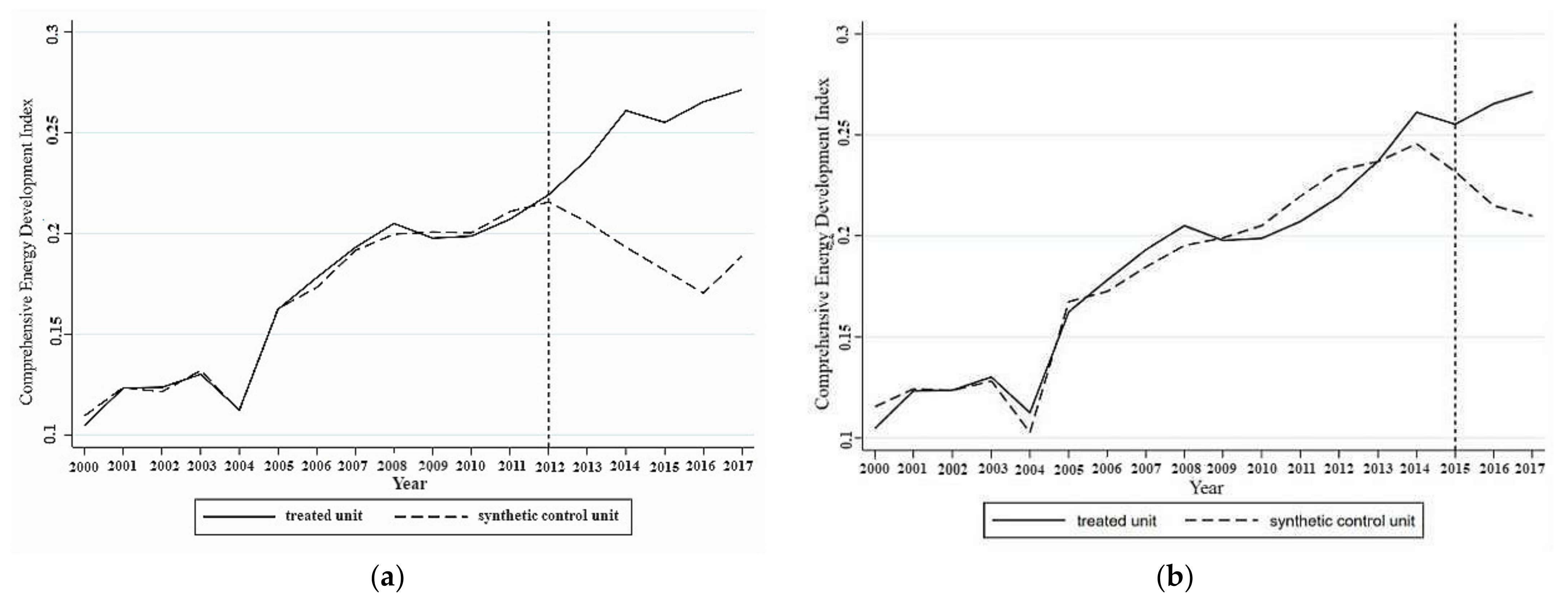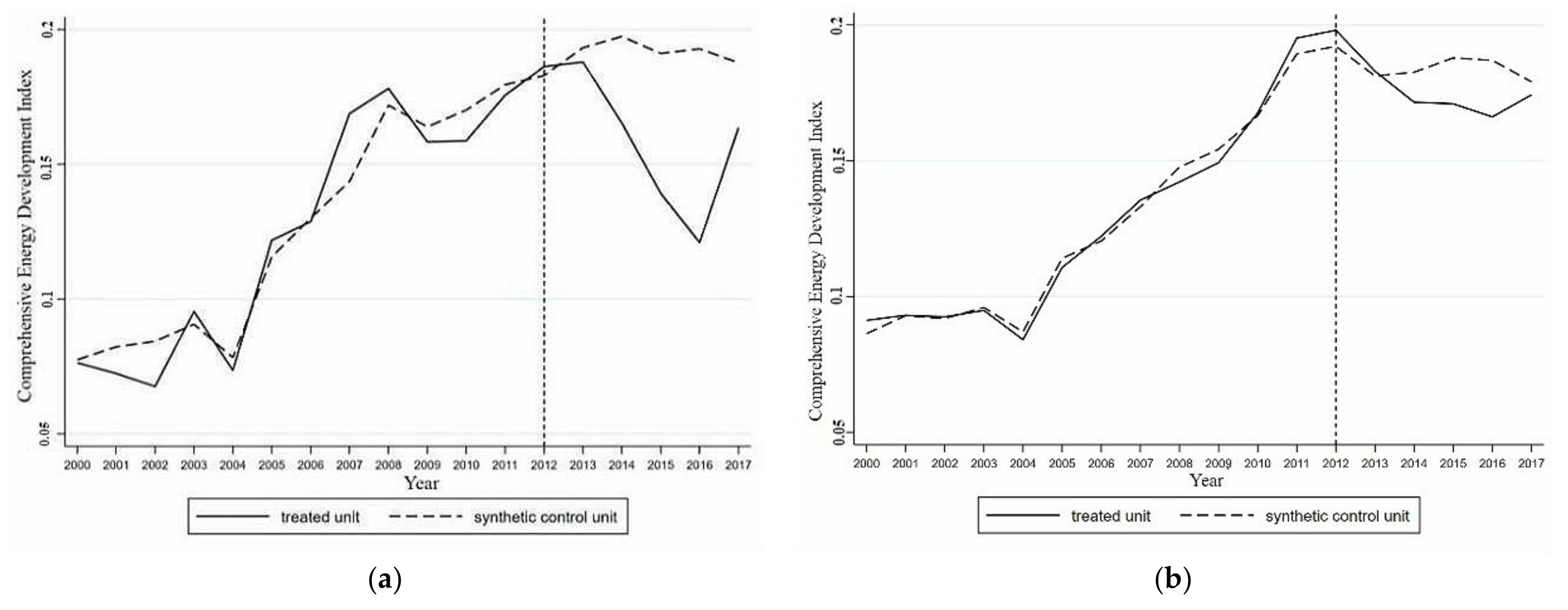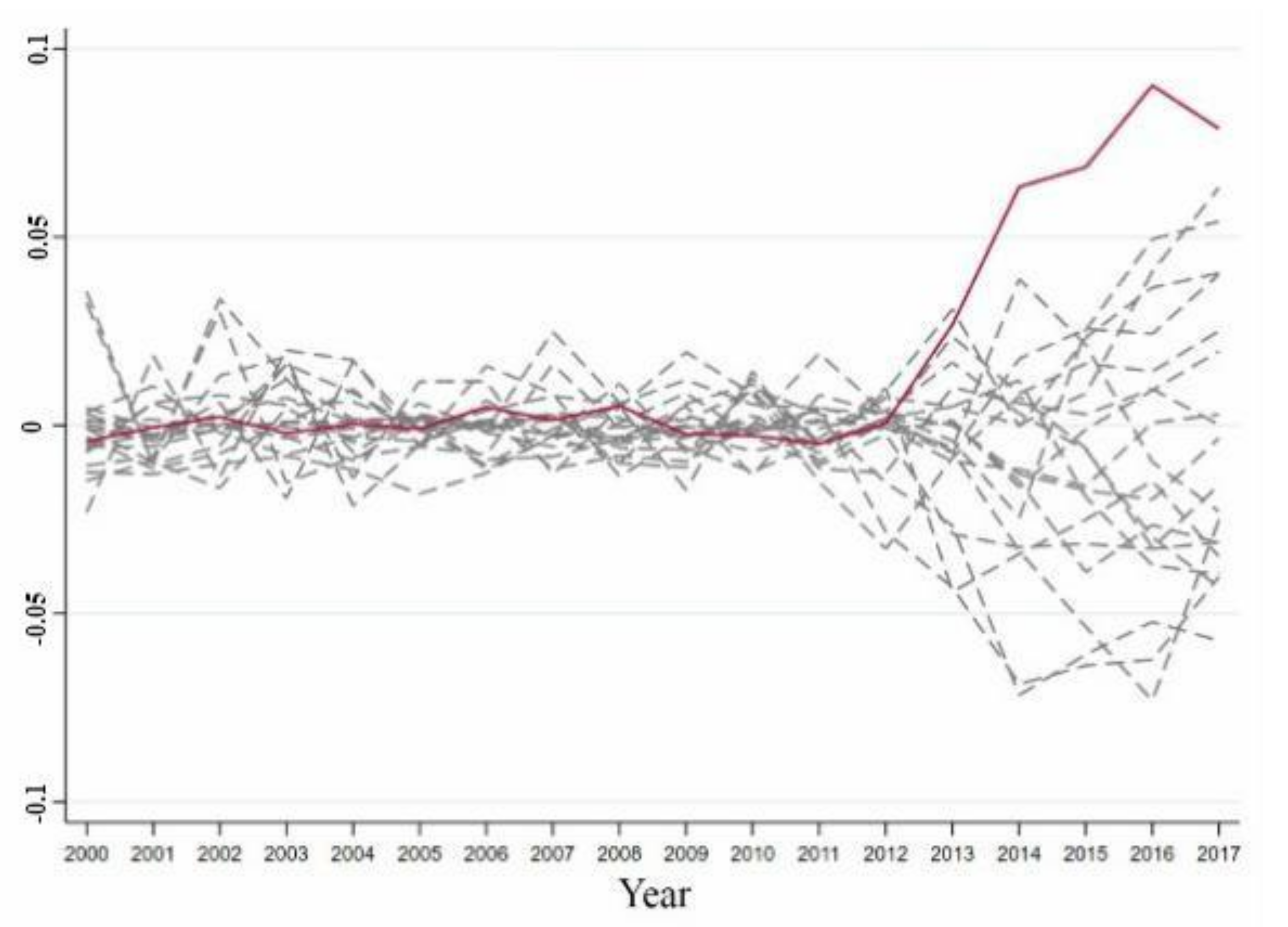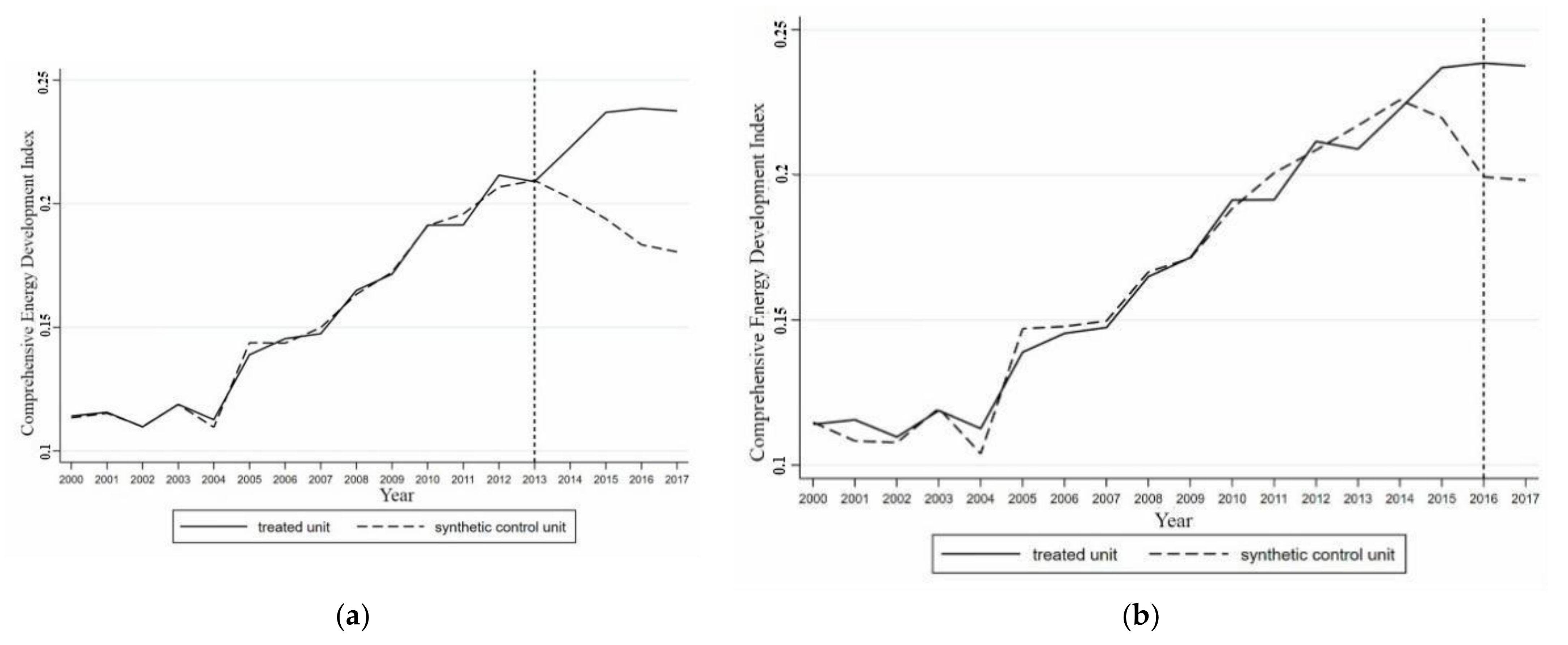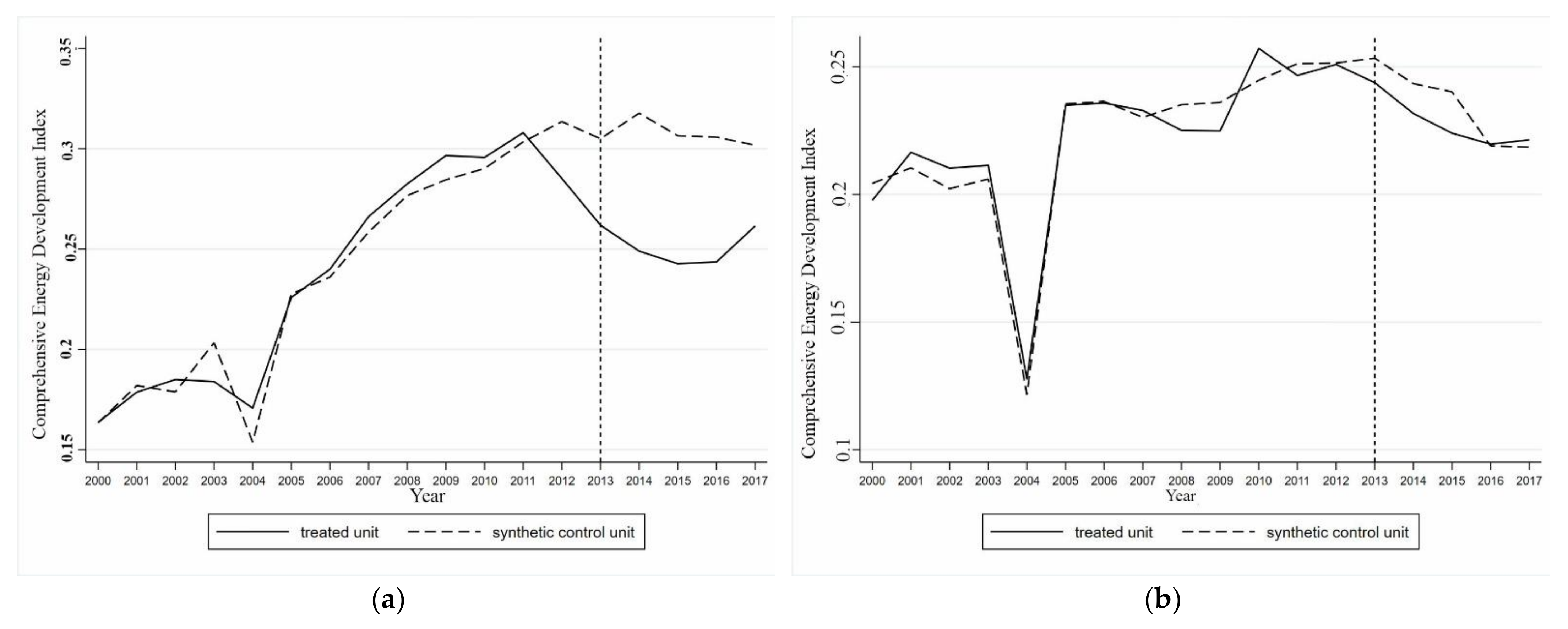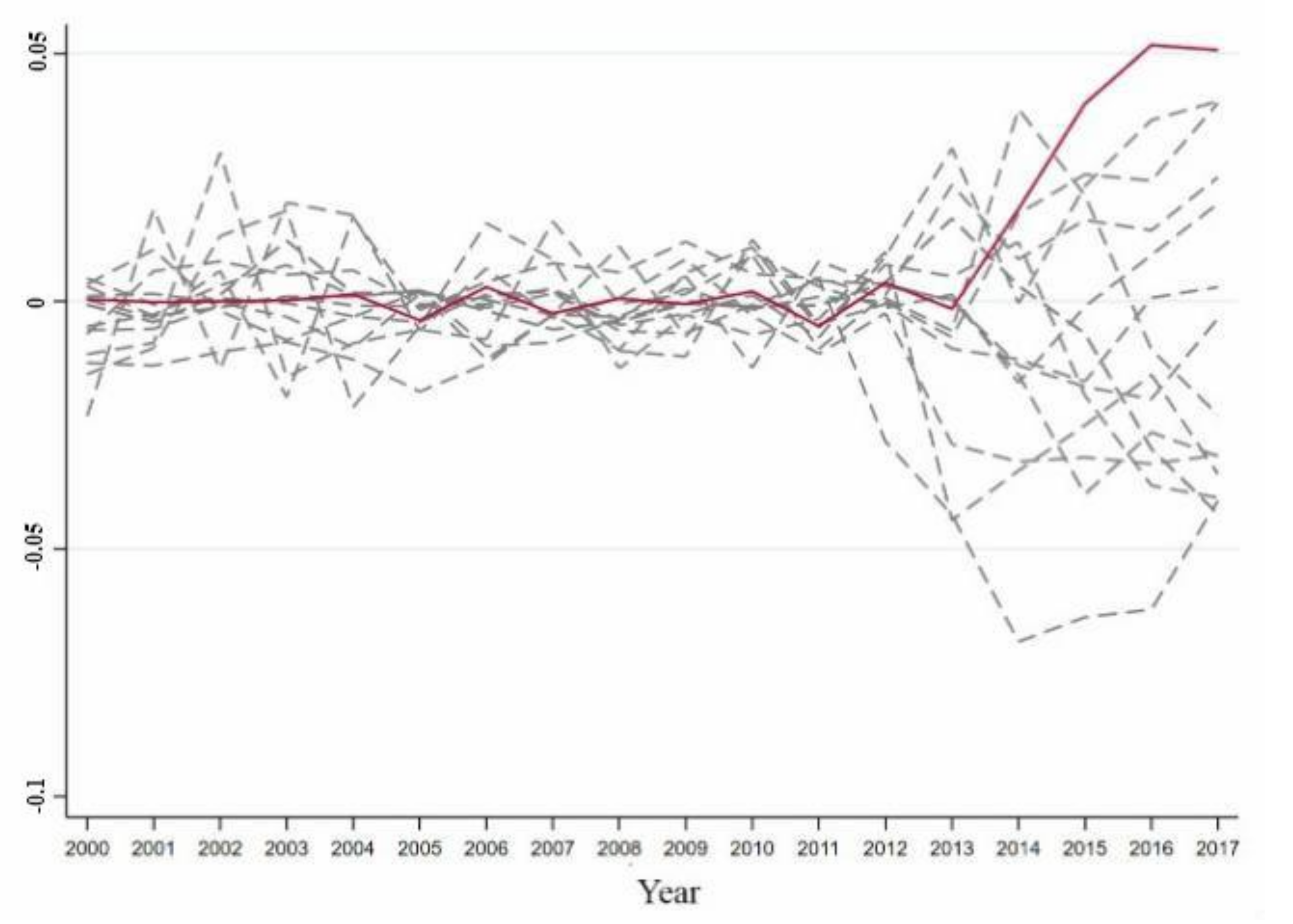3.1. Model Construction
The synthetic control method is a newly emerged method of analysis based on natural experiments in comparative case analysis, proposed by Abadie and Gardeazabal [
45]. In recent years, the method has been continuously improved [
46,
47,
48]. The synthetic control method is mainly used to identify the implementation effect of a certain policy. The basic idea is that due to the heterogeneity of each economy, it is difficult to find an economy with essentially the same attributes and characteristics as the experimental group as a reference group in a realistic scenario, but several known reference groups can be linearly combined into a “composite group” that can better match the basic characteristics of the experimental group. This synthetic control object is the “counterfactual reference group” of the experimental group to be studied without policy interference simulated by the experiment. By comparing the difference between the actual experimental group and the synthetic experimental group, it is possible to know whether the policy under study is effective. This study used the synthetic control method, which is commonly used to evaluate the effects of policy. A comparative experimental study was conducted by considering a region where the coupling of artificial intelligence and energy had been achieved. The development of the local energy industry was considered under two scenarios by comparing a system in which artificial intelligence and the energy industry had been adopted to achieve the coordinated development of coupling with a system without coupling and coordinated development. The result of the comparison revealed the impact of the coupling of the two systems on the development of the energy industry in the study region.
It was assumed that the comprehensive development level of the energy industry in N + 1 provinces could be observed within statistical time [1, T]. The first province (experimental group) in the T0 stage achieved the coupling of artificial intelligence and the energy industry, while the other N provinces did not realize the coupling of artificial intelligence and the energy industry, or local artificial intelligence did not develop during the statistical period. Then, N provinces could be used as a potential reference group for experimental province 1.
represents the comprehensive development index of the energy industry in province i when regional artificial intelligence and the energy industry are coupled in period t. represents the observation result of the comprehensive development level of the regional energy industry in province i without realizing the coupling of artificial intelligence and the energy industry in period t. Therefore, the effect in region i was caused by the coordinated development of artificial intelligence and the energy industry during the period t: , where . According to the above formula, the comprehensive development level of the regional energy industry observed in i province during t period can be expressed as: . Among them, is a dummy variable, representing the integrated development state of artificial intelligence and the energy industry of province i in period t. If province i realized the coupling of artificial intelligence and the energy industry in period t, the value of was 1, and vice versa.
Only the first province realized a coupling between artificial intelligence and the energy industry after
T0, while the other
N provinces did not realize the coupling and coordinated development of regional artificial intelligence and the energy industry at any time in the statistical period. For
period, the coupling effect of the coordinated development of the two systems in the first province on the comprehensive development level of the regional energy industry can be expressed as:
. The aim of this study was to solve
. Because the first region realized the coupling and coordinated development of the two systems,
could be observed in the
period. The comprehensive development level
of the energy industry in the first province without the coupling of the two systems was not observed. The model (1) below was used to calculate the “counterfactual”result
[
46]. The comprehensive development level of the local energy industry in the first province was estimated before the coupling of artificial intelligence and the energy industry has been achieved:
where
is the time fixed effect that affects the development of the energy industry in all provinces. The
(
K × 1) dimension covariable means that the observable control variable was not affected by the coupling effect between artificial intelligence and the energy industry.
is a (1 × K)-dimensional unknown parameter vector.
is a common factor vector with (1 × F) dimensions that cannot be observed.
is a (F × 1)-dimensional coefficient vector, representing the unobservable regional fixed effect. The error term
is a short-term shock that cannot be observed in every province. It was assumed that the mean value of
was 0 at the regional level. This model does not require independence between
,
, and
.
When is a fixed constant—i.e., when the effect of unobservable influencing factors does not change over time—Equation (1) becomes a difference in difference (DID) model. The synthetic control method allows the influence of unobservable factors to change with time, i.e., is a function of time t, rather than a constant term.
To calculate the effect of coupling artificial intelligence and the energy industry on the comprehensive development level of the energy industry, it is necessary to determine if the first province reached the comprehensive development level
of the energy industry under the two-system coupling scenario. An (
N × 1) dimensional weight vector
was introduced,
,
, which satisfied
. When
, a convex combination of reference group provinces was used to synthesize a “counterfactual reference group” to avoid a possible deviation. Each specific value of the vector
W, which is an average weighting of all the regions within the reference group, represented a synthetic control over the first region. When the variable values of each reference group region were weighted, we obtained:
Assuming that there is a weight vector
, this satisfies:
Abadie et al. [
46] proved that if
is a nonsingular matrix, then:
Abadie et al. [
46] proved that under general conditions, Equation (4) approaches 0. Therefore, for
, the unbiased estimate of the counterfactual result for the first province could be approximated by the synthetic control group, i.e.,
. The estimated value of the coupling effect on the comprehensive development level of the local energy industry was obtained when artificial intelligence and the energy industry were coupled:
The key to solving
was to find the synthetic control vector
that makes Equation (3) true. The weight vector
W* was determined by minimizing the distance
between
X1 and
X0W. The distance function between
X1 and
X0W is expressed as
.
X1 is the (m × 1)-dimensional feature vector of the first province before the coupling between artificial intelligence and the energy industry was realized.
X0 is an (m × N)-dimensional matrix, and the
j-th column of
X0 is the feature vector before the coupling of artificial intelligence and the energy industry in region
j.
V is a positive semidefinite matrix with (m × n) dimensional symmetry. To avoid the influence of
V selection on the estimated mean square error of the model, the program developed by Abadie et al. [
46] was used to calculate
V, which resulted in the comprehensive development level of the energy industry in a synthetic area approximate to the comprehensive development level of the local energy industry when the coupling of the two systems was not realized. The comprehensive development level of the energy industry in the synthetic control area, which was obtained by weighting, could be used as an unbiased estimate of the comprehensive development level of the energy industry in a hypothetical area without the coupling of artificial intelligence and the energy industry. The difference in the comprehensive development level of the energy industry between the regions where artificial intelligence and the energy industry were coupled and the synthetic regions that were derived from the calculation reflected the coupling effect of the two systems on the comprehensive development level of the local energy industry.
3.2. Variable Selection
3.2.1. Variable Descriptions and Data Sources
In this study, the comprehensive development index of the energy industry in 30 provinces of China from 2000 to 2017 was calculated using a comprehensive development index of the energy industry. This enabled changes in the comprehensive development of the regional energy industry to be measured. This value was then used as the prediction result variable in the synthetic control method. The comprehensive development index of the energy industry and artificial intelligence is shown in
Table 1 and
Table 2, and the comprehensive development index of the energy industry for the 30 provinces is shown in
Table A1 of the
Appendix A.
This paper mainly adopts the method of literature analysis to establish the evaluation index system of energy industry. The frequency analysis is carried out for the literature about the comprehensive index system of energy industry in China Knowledge Network, and the relevant evaluation indexes of energy industry used in recent years with high frequency and the structure division way of index system are selected. Combined with data availability, the following 10 indicators were finally selected to construct a comprehensive evaluation index system of China’ energy industry from three levels: total, structure and quality of the energy industry. Although the automation index can reflect the development of energy industry, it is difficult to obtain data, so it cannot be included in this index. China’ energy industry includes five sub-sectors: coal mining and processing, oil and natural gas extraction, petroleum processing and coking, electricity and steam, and hot water production and supply. Some provinces lack industrial investment data; therefore, the coal mining and washing industry and the oil and natural gas mining industry were combined into one indicator, referred to as the coal and oil mining industry. The unit industrial added value was calculated from the ratio of the terminal energy consumption to the industrial added value, and the power processing conversion rate was calculated from the input and output data of thermal power in the energy balance sheet.
No scientific research paper has yet measured the comprehensive development status of AI through the method of constructing an evaluation index system. With reference to the data analysis reports related to AI released by major consulting firms and considering the extremely low availability of AI-related data, the preliminary construction of a comprehensive evaluation index system for the development status of AI is revised. The comprehensive development status of AI in China is measured from three levels: public attention, technology and science education level, and market attention. Among them, the number of high-level papers refers to the geometric mean number of papers presented at top international academic conferences in AI, which eliminates the influence of the size of the number of paper co-authors on the average level of published high-level papers, and the number of pages must be greater than or equal to 6 pages to be counted. The number of high-level scholars is defined as scholars who have presented at least one high-level paper at a top academic conference in AI. The investment amount metric is derived from statistical analysis of data related to financing events obtained by AI companies. The investment amount of US dollar funds is converted using the average value of the exchange rate of US dollar to RMB in the current year. The known investment amounts of the investment rounds were weighted and averaged to obtain the weighted average of the amount invested in each round, which was used as the financing amount of undisclosed information. The final amount of investment received by AI companies was obtained.
The economic indicators mentioned above were all converted by the GDP deflator to eliminate the impact of inflation. The standard coal reference coefficients of various energy sources involved in the calculation process were determined with reference to the standards given in the China Energy Statistics Yearbook. The conversion coefficients of coal, oil, and natural gas were 0.7143 kg of standard coal/kg, 1.45 kg of standard coal/kg, and 1.33 kg of standard coal/m3, respectively. The data related to the energy industry covered in this paper were obtained from the National Bureau of Statistics, the China Energy Statistical Yearbook from 2001–2018, and the regional statistical yearbooks of provinces and cities from 2001–2018. The data related to artificial intelligence are obtained from Baidu, INNOJOY patent search engine, CSRankings website, Hit Database, and Enterprise database of IT oranges.
To guarantee the fitting effect of the synthetic control object and the robustness of the result, several key factors that affected the development of the regional energy industry were included as predictive control variables, i.e., per capita GDP (
pgdp), level of education per capita (
pedu), fiscal spending as a share of GDP (
gov), foreign investment as a share of GDP (
fi), industrial structure (
ind), and the level of science and technology (
tec). The per capita GDP was used to measure the level of economic development of a region [
54]. The level of education per capita was represented by the proportion of employed people with college level or higher education in the region [
55], which reflected both the regional educational level and the quality of human resources. The ratio of fiscal expenditure to GDP was used to measure the government’s support for the market [
56]. The ratio of foreign investment to GDP was used to reflect the impact of foreign technology on Chinese enterprises [
57], and the industrial structure was expressed as the ratio of the added value of the regional secondary industry to GDP [
58]. The level of science and technology was expressed by the number of regional patent applications granted [
59]. To improve the fitting effect of the synthetic control method and the accuracy of the model, the lagged term of the comprehensive development index of the regional energy industry was considered part of the control variable by referring to Delaney and Kearney [
60].
The entropy method was used to calculate the comprehensive development index of the energy industry. A comprehensive evaluation model of the energy industry was constructed based on the comprehensive evaluation index of the energy industry shown in
Table 1. The detailed calculation formula was as follows:
where
E(x) represents the comprehensive development index of the energy industry,
wj is the weight of the
j-th index calculated by the entropy weight method, and
X′ij is the normalized value of a sample used in the entropy weight method.
The index data standardization method was as follows. Positive indexes refer to evaluation indexes where larger values are considered better. For positive indicators, the standardized treatment formula (7) was used:
Reverse indexes refer to evaluation indexes where smaller values are considered better. The standardized processing formula (8) was adopted for the reverse indexes:
Because the entropy method contains the calculation link of the logarithm in the solution process, a value of 0.001 was added to the data obtained after standardization to avoid a 0 value in the standardized data.
The evaluation index data related to the energy industry of all provinces in China from 2000 to 2017 were calculated from the China Energy Statistical Yearbook from 2001 to 2018 and the regional statistical yearbooks released by all provinces. The relevant data for the six predictive control variables were obtained from the National Bureau of Statistics, China Statistical Yearbook, China Population and Employment Statistical Yearbook, and China Labor Statistical Yearbook from 2001 to 2018.
3.2.2. Selection of Cities in the Experimental Group
According to the comprehensive development index of the energy industry of 30 provinces in China from 2000 to 2017, among the five representative provinces where artificial intelligence is concentrated Guangdong has the highest level of comprehensive development in the energy industry, while Jiangsu was ranked second. The comprehensive development level of the energy industry in Beijing and Shanghai was the lowest level among the 30 provinces, which was consistent with their geographical location, resource endowment, and economic development plan. The comprehensive development level of the energy industry in Zhejiang was in the middle to lower level among the 30 provinces, with a small improvement over the 18 years.
In summary, Guangdong and Jiangsu were selected as the experimental group provinces to test the effect of the coupled development of artificial intelligence and the energy industry on the local energy industry, and the results obtained were then considered convincing. Beijing, Shanghai, and Zhejiang, whose energy industries have been affected by the local development of artificial intelligence to varying degrees, were removed from the reference group of Guangdong and Jiangsu. The final reference group included 26 other regions, excluding Beijing, Shanghai, Zhejiang, and Xizang.
3.2.3. Selection of Time Points
The coupled development of artificial intelligence and the energy industry had two levels: coupling and coupling coordination. To determine whether the two systems of artificial intelligence and the energy industry could be coupled to the development of the local energy industry after the coupling or the coupling and coordinated development were achieved, time points for both the coupling of the two systems and the coupling coordination of the two systems were selected.
The coupling degree, coordination degree, and stage distribution of artificial intelligence and the energy industry in China are shown in
Table 3. A value of 0.5 was taken as the threshold value of both the coupling degree and coupling coordination degree. When the coupling degree of regional artificial intelligence and the energy industry exceeded 0.5, it was considered that the development of the two systems has reached a stable coupling stage. Similarly, when the coupling coordination degree of the two systems exceeded 0.5, it was considered that the two systems had reached a stable coupling and coordination stage. According to the coupling degree measurements presented in
Table 1 of the
Appendix A, the coupling degree of artificial intelligence and the energy industry in Guangdong exceeded the threshold value of 0.5 for the first time in 2012, and the coupling coordination degree of the two systems exceeded the threshold value of 0.5 in 2015. Therefore, the selected time points for the coupling effect in Guangdong were 2012 and 2015, respectively. The coupling effect on the energy industry could only be evaluated when the degree of integration between artificial intelligence and the energy industry was determined by comparing the synthetic results.
From 2011 to 2017, the coupling degree of artificial intelligence and the energy industry in Jiangsu was higher than 0.5. However, according to the analysis, the coupling degree of the two systems in Jiangsu fluctuated, with an initial decrease and then an increase, with 2013 being a turning point. Therefore, 2013 was selected as the time point for a stable coupling between artificial intelligence and the energy industry in Jiangsu. Similarly, although the coupling coordination degree between artificial intelligence and the energy industry in Jiangsu exceeded the threshold value of 0.5 in 2011, eventually reaching 0.55, the coordination level only remained stable for one year, i.e., 2011. After four years, the coupling coordination degree improved steadily and exceeded 0.5 again in 2016. The trend of continuous improvement continued in 2017. In summary, 2016 was selected as the time point for the two systems to achieve stable coupling and coordinated development.
